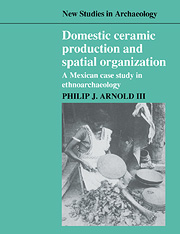Book contents
- Frontmatter
- Contents
- List of figures
- List of tables
- Acknowledgements
- 1 Introduction
- Part 1 Ceramic production and consumption in Los Tuxtlas
- Part 2 Ceramic production and spatial organization
- Part 3 Application and implication
- 8 Ceramic production organization in archaeological perspective
- 9 Conclusion
- References
- Index
8 - Ceramic production organization in archaeological perspective
Published online by Cambridge University Press: 02 December 2009
- Frontmatter
- Contents
- List of figures
- List of tables
- Acknowledgements
- 1 Introduction
- Part 1 Ceramic production and consumption in Los Tuxtlas
- Part 2 Ceramic production and spatial organization
- Part 3 Application and implication
- 8 Ceramic production organization in archaeological perspective
- 9 Conclusion
- References
- Index
Summary
Actualistic studies can be notoriously difficult to apply archaeologically. In most cases, the need for middle-range research evolved out of ambiguity in archaeological material that had already been recovered. Since the results of middle-range research have usually followed on the heels of archaeological fieldwork, it is hardly surprising to find that potentially pertinent archaeological data may not have been collected, or the collection procedures were not congruent with the findings of actualistic studies.
This fact, however, should not dampen the applicability of middle-range research to archaeological material. In addition to identifying new methods for conceptualizing and retrieving information, actualistic studies must be sufficiently flexible to expand the information potential of a pre-existing archaeological data base. The possible information inherent in archaeological remains already recovered cannot be overlooked.
This chapter applies some of the spatial concepts developed in this study to a recently documented Mesoamerican ceramic production system. To be useful, a concern with the spatial organization of pottery making should contribute at two levels of analysis. First, this focus should be able to differentiate between various production entities and supply information on the character of ceramic manufacture. Second, the principles of organizational structure should enable the archaeologists to monitor variability within a given production mode. As noted previously, a static approach to organization is one of the main weaknesses in the conventional model of pottery production (Rice 1984a:233; van der Leeuw 1984:720).
- Type
- Chapter
- Information
- Domestic Ceramic Production and Spatial OrganizationA Mexican Case Study in Ethnoarchaeology, pp. 141 - 151Publisher: Cambridge University PressPrint publication year: 1991



